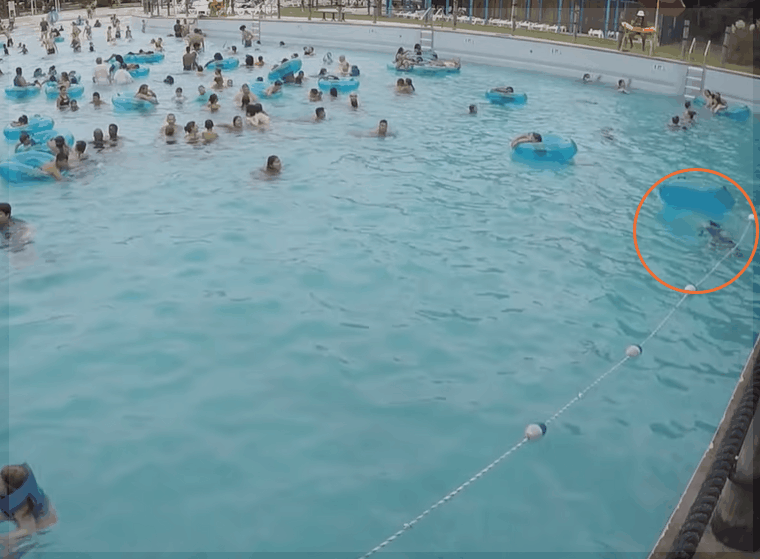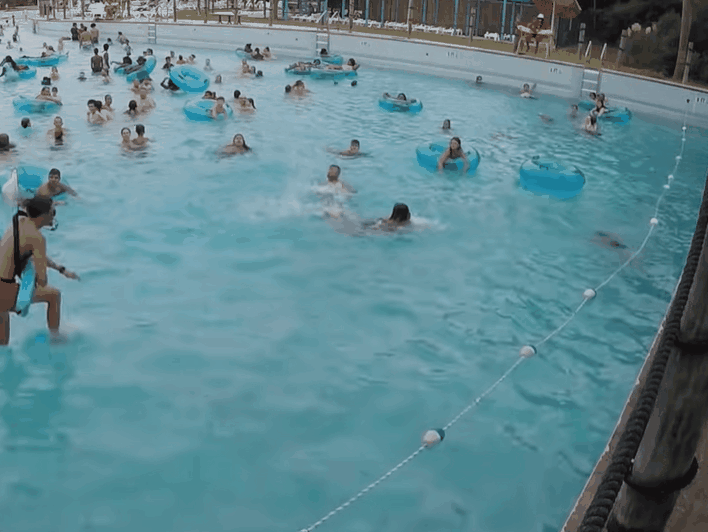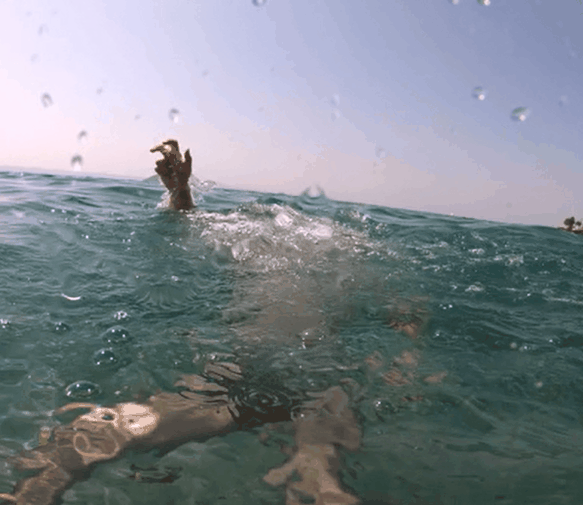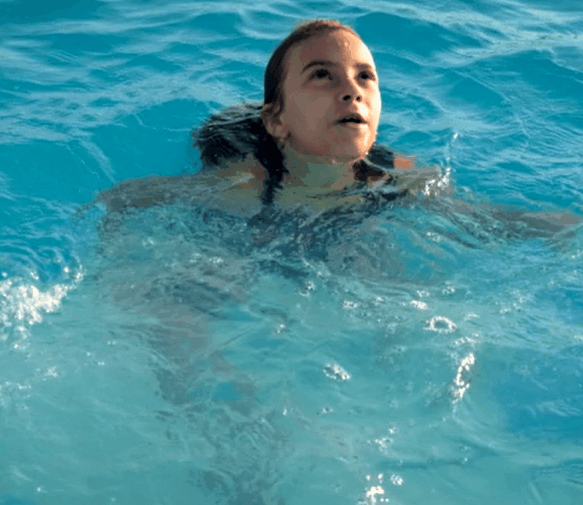No screaming for help or waving arms: a visual guide to identifying someone drowning
Drowning is the third main cause of unintentional trauma death in the world. According to the UN World Report on Drowning, more than 40 people lose their lives every hour in this way

In Spain, 249 people have drowned in the first seven months of the year. This is 12.6% more than in the same period of 2022.
Sometimes people die from struggling against the waves or currents. Other times, they drown suddenly, without screaming: these are the so-called "silent" drownings.
In a matter of seconds, a person can drown without anyone noticing it. These are the most common stages of drowning:
Common
stages
Swimmer
A swimmer breathes rhythmically, tends to be horizontal and moves in an obvious direction.
Loss of
control
A swimmer starts to drown due to loss of control, not knowing how to swim, a strong current, or a previous pathology such as an epileptic seizure or a heart attack, among others.
Water
distress
SOS
Water distress is the phase prior to drowning. The person continues to breathe and calls for help.
SOS
Drowning
In drowning, the body acts reflexively to avoid suffocation. The victim cannot call for help.
Submersion
A victim spends between 20 and 60 seconds at the surface before submersion.

In Spain, 249 people have drowned in the first seven months of the year. This is 12.6% more than in the same period of 2022.
Sometimes people die from struggling against the waves or currents. Other times, they drown suddenly, without screaming: these are the so-called "silent" drownings.
In a matter of seconds, a person can drown without anyone noticing it. These are the most common stages of drowning:
Common
stages
Swimmer
A swimmer breathes rhythmically, tends to be horizontal and moves in an obvious direction.
Loss of
control
A swimmer starts to drown due to loss of control, not knowing how to swim, a strong current, or a previous pathology such as an epileptic seizure or a heart attack, among others.
Water
distress
SOS
Water distress is the phase prior to drowning. The person continues to breathe and calls for help.
SOS
Drowning
In drowning, the body acts reflexively to avoid suffocation. The victim cannot call for help.
Submersion
A victim spends between 20 and 60 seconds at the surface before submersion.

In Spain, 249 people have drowned in the first seven months of the year. This is 12.6% more than in the same period of 2022.
Sometimes people die from struggling against the waves or currents. Other times, they drown suddenly, without screaming: these are the so-called "silent" drownings.
In a matter of seconds, a person can drown without anyone noticing it. These are the most common stages of drowning:
Common
stages
Swimmer
A swimmer breathes rhythmically, tends to be horizontal and moves in an obvious direction.
Loss of
control
A swimmer starts to drown due to loss of control, not knowing how to swim, a strong current, or a previous pathology such as an epileptic seizure or a heart attack, among others.
SOS
Water
distress
Water distress is the phase prior to drowning. The person continues to breathe and
calls for help.
SOS
Drowning
In drowning, the body acts reflexively to avoid suffocation. The victim cannot call for help.
Submersion
A victim spends between 20 and 60 seconds at the surface before submersion.

In Spain, 249 people have drowned in the first seven months of the year. This is 12.6% more than in the same period of 2022.
Sometimes people die from struggling against the waves or currents. Other times, they drown suddenly, without screaming: these are the so-called "silent" drownings.
In a matter of seconds, a person can drown without anyone noticing it. These are the most common stages of drowning:
Common
stages
Swimmer
A swimmer breathes rhythmically, tends to be horizontal and moves in an obvious direction.
Loss of
control
A swimmer starts to drown due to loss of control, not knowing how to swim, a strong current, or a previous pathology such as an epileptic seizure or a heart attack, among others.
SOS
Water
distress
Water distress is the phase prior to drowning. The person continues to breathe and
calls for help.
SOS
Drowning
In drowning, the body acts reflexively to avoid suffocation. The victim cannot call for help.
Submersion
A victim spends between 20 and 60 seconds at the surface before submersion.
When someone is drowning, it doesn’t always look like they are drowning. The process is fast, quiet, and lethal. In fact, in many cases the victim drowns surrounded by other bathers oblivious to the drama unfolding around them. These are the so-called silent drownings. “The belief that a drowning person screams, waves their arms and calls for help has been popularized,” says Roberto Jesús Barcala, professor of lifeguarding at the Faculty of Sports Sciences in Pontevedra, Spain. “But this only happens in movies and television.” That’s why, Barcala explains, we have to change the way society perceives how a drowning occurs: “We have to educate people to look for other signs.”
In many cases, until a lifeguard rushes to the rescue, other bathers are unaware of the danger, as seen in the following footage from a swimming pool in the United States.
1. A girl falls from the float

Source: Lifeguard Rescue (YouTube channel)
2. The lifesaver jumps in to rescue her
Few people notice that something is wrong. In a matter of seconds, the lifeguard detects that she is drowning and rushes to her.

Source: Lifeguard Rescue (YouTube channel)
The drowning scenes depicted in television shows and movies do not fit this pattern. They correspond only to a particular type of drowning, in a particular phase. “If you are a proficient swimmer and you have a cramp, you can call for help for a while,” Barcala points out. “But that’s not the usual pattern.” This more dramatic process, however, is what TV and movies generally depict, from Jaws to Baywatch.
The following scenes are dramatic representations that do not correspond to a real drowning incident:
Non-realistic depictions of drowning



Source: Getty
If you observe someone screaming for help and waving their arms, as in the above cases, it is very likely that they are an experienced swimmer who has suffered a cramp or a muscle pull, and is in distress. These actions indicate that the person is very close to drowning.
The following simulated scene, on the other hand, is a much closer representation of the exact moment of drowning:
Realistic depiction of the moment of drowning

Source: Getty (Note: this is a dramatic reconstruction of a drowning.)
The instinctive drowning response (IDR) is what people do to avoid the real or perceived threat of suffocation in water. It is characterized by the following behaviors:

How to identify a case of drowning
1.
The body remains vertical in the water, without supporting kicks. The legs move as if walking up a flight of stairs.
Straight body
Legs climbing ‘invisible steps’
2.
The person is unable to call for help. The respiratory system is focused solely on trying to breathe, not on speech, a secondary function.
Air
SOS
Lungs focusing on breathing
3.
The arms become outstretched and apply pressure to the surface of the water. They are unable to make voluntary movements such as signaling for help.
SOS
Oustretched arms pressing against the surface of the water
4.
The head is tilted backward with the mouth open at water level
Hair on forehead and eyes
Water
Head tilted back
Source: Mario Vittone and Dr. Francesco A. Pia, United States Coast Guard On Scene Magazine (2006).

How to identify a case of drowning
1.
The body remains vertical in the water, without supporting kicks. The legs move as if walking up a flight of stairs.
Straight body
Legs climbing ‘invisible steps’
2.
The person is unable to call for help. The respiratory system is focused solely on trying to breathe, not on speech, a secondary function.
Air
SOS
Lungs focusing on breathing
3.
The arms become outstretched and apply pressure to the surface of the water. They are unable to make voluntary movements such as signaling for help.
SOS
Oustretched arms pressing against the surface of the water
4.
The head is tilted backward with the mouth open at water level
Hair on forehead and eyes
Water
Head tilted back
Source: Mario Vittone and Dr. Francesco A. Pia, United States Coast Guard On Scene Magazine (2006).

How to identify a case of drowning
1.
The body remains vertical in the water, without supporting kicks. The legs move as if walking up a flight of stairs.
Straight body
Legs climbing ‘invisible steps’
2.
The person is unable to call for help. The respiratory system is focused solely on trying to breathe, not on speech, a secondary function.
Air
SOS
Lungs focusing on breathing
3.
The arms become outstretched and apply pressure to the surface of the water. They are unable to make voluntary movements such as signaling for help.
SOS
Oustretched arms pressing against the surface of the water
4.
The head is tilted backward with the mouth open at water level
Hair on forehead and eyes
Water
Head tilted back
Source: Mario Vittone and Dr. Francesco A. Pia, United States Coast Guard On Scene Magazine (2006).

How to identify a case of drowning
1.
2.
The body remains vertical in the water, without supporting kicks. The legs move as if walking up a flight of stairs.
The person is unable to call for help. The respiratory system is focused solely on trying to breathe, not on speech, a secondary function.
Air
SOS
Lungs focusing on breathing
Straight body
Legs climbing ‘invisible steps’
3.
4.
The arms become outstretched and apply pressure to the surface of the water. They are unable to make voluntary movements such as signaling for help.
The head is tilted backward with the mouth open at water level
Hair on forehead and eyes
SOS
Water
Head tilted back
Oustretched arms pressing against the surface of the water
Source: Mario Vittone and Dr. Francesco A. Pia, United States Coast Guard On Scene Magazine (2006).
2.5 million drowning deaths in 10 years
Drowning is the third main cause of unintentional trauma death in the world. According to the UN World Report on Drowning, more than 40 people lose their lives every hour in this way. “In total drowning has caused over 2.5 million deaths in the last decade, but it is a very preventable cause of death,” explains David Meddings, author of the study, via email.
In Spain, so far this year (from January 1 to July 31), 249 people have died in this way, according to the National Drowning Report of the Royal Spanish Federation of Rescue and Lifesaving (RFESS). Last June, 57 people drowned, the second deadliest month in the last nine years. “It’s because of the heat,” says Barcala. “There is a direct relationship between temperatures, sunny days, and drowning. And the forecast is that in the coming years there will be more heat waves due to climate change, so there will be more drowning.”
As the WHO states: “Anyone can drown. But it shouldn’t happen to anyone.” The overwhelming majority of drowning deaths affect men: 87%, an overrepresentation that Meddings puts down to “their greater propensity to take risks and, in many countries, because of its association with alcohol consumption in and around the water.” It is also the case that fishing is a very male-dominated profession.
With regard to age, more than half of all victims in 2022 were 50 and over (55%). This is because drowning is often the consequence of a previous pathology (heart attack, fainting episode, pulled muscle etc.) At the other end of the scale, 23 children under the age of five drowned last year.
Sixty-five percent of drownings are concentrated in the period between 12:00 p.m. and 8:00 p.m., as these are the hottest times of the day and when most people swim. In the case of Spain, “Children under four years of age mostly drown between 3 p.m. and 6 p.m.,” says Barcala. “It is due to lack of supervision; it coincides with the adults eating.” Constant and active vigilance is paramount in the case of minors. Some experts advise appointing a “water watcher” among adults when several families are together.
Drowning for love
Barcala and a team of international experts analyzed dozens of videos to try and define a standard drowning. In all cases, the process lasted less than two minutes. Early detection, then, is critical to saving lives. But identifying someone who is drowning is not the same as saving them. To do so, it is advisable to follow a series of tips. The first is to call the emergency services before jumping into the water. Secondly, to analyze the dangers of the situation. “When there are multiple victims in a drowning, it is usually family members who jump in to save the first victim. This is what Australians call drowning for love,” says the expert.
That is why it is advisable to go to the beach with floating objects that can be worn (such as a life vest) or that can be thrown (such as a float or a bottle tied to a rope) to minimize risk and ensure a safe rescue. In any case, it is important to remember that swimming is not the same as trying to rescue someone.
Miguel Ángel Sánchez Arrocha, head of the Red Cross Emergency Unit, points out that “self-protection is essential. There is institutional protection and it is always preferable to go to a beach with a lifeguard, but individual responsibility is equally important.” In addition, he advises swimmers to always swim parallel to the coast, as this way they will have a greater margin to get to safety in case of a dizzy spell, cramp, or another unforeseen event.
Sánchez Arrocha compares road safety awareness with safety in the sea: in the same way nobody runs a red light, no one should swim when there is a red flag. Equally, “if you drink, don’t drive” can easily be applied to “if you drink, don’t swim.” The allusion to road safety is not accidental. Awareness campaigns in recent years have led to a steady decline in road deaths. Meanwhile, the number of drownings on beaches and at swimming pools has remained worryingly stable.
Sign up for our weekly newsletter to get more English-language news coverage from EL PAÍS USA Edition
More information

